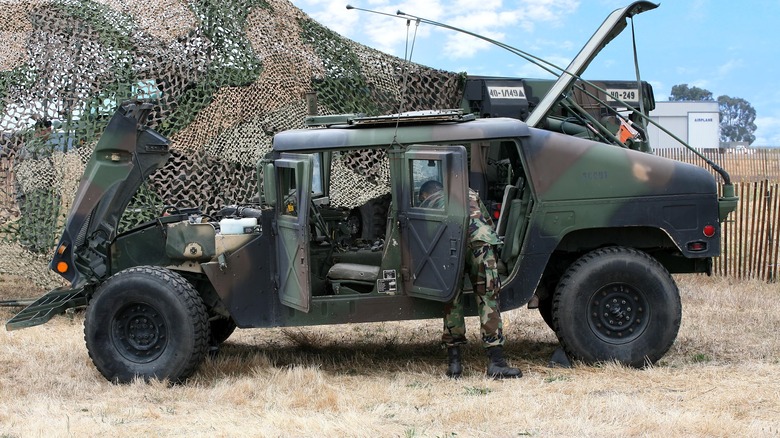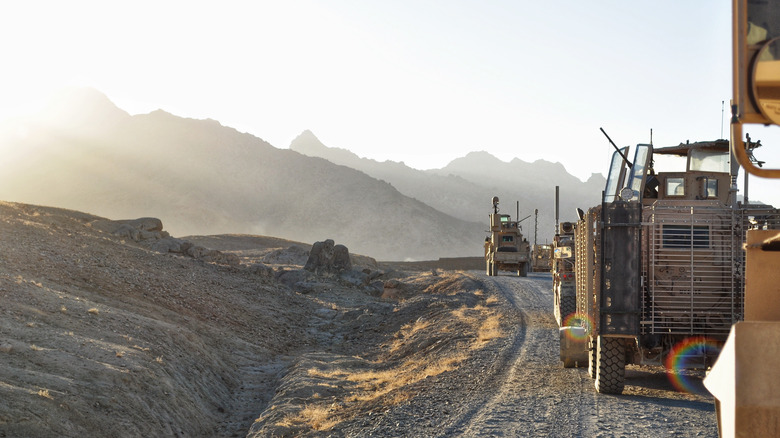Keeping Soldiers Cool In The Middle East Cost The US Military A Whopping Amount
With summer comes increased temperatures, spiking humidity indexes, and — for many Americans — higher energy consumption. Although air conditioning can create year-round comfort for people with a cooling unit, it also sucks up energy, and along with that energy, your hard-earned dollars. In 2018, almost 12% of the average America's energy consumption is spent on A/C, an amount that averages some $265 per household, according to the U.S. Energy Information Administration.
Air conditioning costs can be high for the U.S. military, too. According to a 2011 report by NPR, troops stationed in hot areas like Iraq and Afghanistan have historically needed to have access to air conditioning. In these regions — where the temperature regularly reaches into the high 90s during the summer (via Champion Traveler) — there have been huge costs associated with keeping American troops cool and comfortable during active military conflicts like the Iraq War and the War in Afghanistan. In fact, according to some expert estimates, fuel and infrastructure costs for cooling systems in Iraq and Afghanistan added up to more than $20 billion per year in 2011 (per NPR).
Why A/C costs so much
Before we get into any details, we should say this estimate, which comes from a former Pentagon official named Steven Anderson, was disputed by the U.S. government itself (via NPR). According to them, the true energy costs were much lower: The total fuel budget for Afghanistan in 2011 was $1.5 billion for eight months, they said, with the air conditioning costs comprising only part of that total.
Still, whether the answer is in millions or billions, it's clear that hefty sums were spent on air conditioning for American troops in the Middle East. So why was the number so high? It comes down to logistical issues. For one, U.S. military operations weren't always set up in permanent buildings with good temperature controls. Instead, many operations in Iraq and Afghanistan were carried out from tents which could quickly lose air conditioning to the desert heat. That means more energy in the form of fuel needed to be used to keep the temperatures down, NPR says. "In essence, what we're doing is we're air conditioning the desert over there in Afghanistan, Iraq, and other places," said Steven Anderson (via The Week, in 2015).
There are strategies which could be used to manage these expenditures. For instance, a series of tests showed that using a particular foam to insulate tents could significantly decrease heating inefficiencies, NPR notes. But it's unclear if that foam was ever used on a widespread scale.
It's expensive to get fuel into Afghanistan
On top of issues with energy efficiency, it was an expensive process just to get gas into Afghanistan. Unlike in the U.S., troops couldn't exactly just run out to the gas station for a quick refill. Instead, every bit of fuel for the U.S. army had to be brought in on long, winding roads, according to NPR. This was costly in terms of time, taking 18 days to get fuel into the country. It also cost a significant amount of money, with all the different infrastructure necessary. For instance, that $20 billion estimate for the cost of A/C? That includes the cost of maintaining roads for fuel convoys.
More than any of that, though, were casualties — soldiers died trying to get fuel for, among other things, air conditioning. With fuel convoys vulnerable to attack, that means there was more than just a financial cost involved with obtaining A/C (via Think Progress).
Given all this information, you might wonder if the A/C was really worth all of the costs. Couldn't soldiers — like many locals — get by without air conditioning? The truth is, it depends.
What temperatures the human body can endure
It's not as easy as you'd think to say what outdoor temperature humans can endure. That's because humidity is an important factor in how our bodies respond to heat, according to India Today.
Most humans can endure a "wet bulb" temperature of 95 degrees maximum (via Live Science). That is the temperature that shows on a thermometer draped in a damp cloth. To reach a temperature of this level, you need to have high humidity and high heat. For instance, an air temperature of 102 and a humidity of 77% puts the wet bulb temp at 95, Live Science says. Most of the time, Afghanistan doesn't reach these levels. Because it's so dry, even though temperatures regularly hit the high nineties (via Champion Traveler), the wet bulb stays below the critical threshold.
Still, that doesn't mean air conditioning isn't important. People can get sick from or even die of heat illness or heat stroke at well below 95 degrees, especially if they're exercising, Live Science says. And people who aren't used to hot temperatures — like, say, Americans from cooler regions who come to Afghanistan — have a harder time adjusting to heat, according to FiveThirtyEight. So that air conditioning in Afghanistan? Wasn't necessarily wasted.



